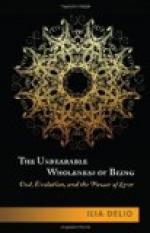These suggestions purpose to explain the inception of an ecstatic love; but the true metaphysical erotic is born and needs no outside stimulus; his heart yearns for the inaccessible from the very beginning. There are certain elements of feeling which must be present in his soul simultaneously: a religious elementary feeling tending to the metaphysical; the need of a sacred—a divine—being, as the foundation of all existing things; a powerful and purely spiritual craving for love, hurt, perhaps unconsciously, in early youth, and finally an imagination endowed with plastic force—artistic tendencies. In the case of the mystic the soul, too, is filled with the consciousness of the divine; he, too, has the capacity for a great love, but with him it is not the love of woman, but of something universal, not individualised, the world, the cosmos, God.
While the mystic attempts to embody the inconceivable Deity in his soul, the worshipper of the Madonna, like the artist, imaginatively creates a being which he sets up for contemplation at the greatest possible distance. The mystic is blind, as it were; he is yearning personified, and he would force God into his soul. The metaphysical lover needs a plastic figure which, in the extremest case, may represent the whole world to him, and this figure must be a woman. It is a historical accident that this woman is frequently connected with a woman of ecclesiastical tradition, an accident strengthened by insufficient creative power on the part of the lover, or lack of courage and self-confidence. He is grateful for the support given to him by tradition. The greatest metaphysical lovers, Dante, Goethe and Michelangelo, freely created the objects of their love; the Protestant Goethe—whom some people even accuse of paganism—clung more closely than either of the others to the Mary of Catholicism (in the final scene of Faust). The worship of the Madonna is the love of great solitary souls, and—as is proved by Goethe—of the great souls in the hours of their last solitude.
While there was only unindividualised sexual instinct, the chastity of woman was of no account; we have seen that neither the Eastern nations nor the Greeks attached any value to it. The woman who had best fulfilled her vocation as a mother, was the woman most highly respected. In the East, as well as with Jews and Romans, a woman could be divorced by her husband for sterility. The only women who were, to some extent, appreciated for their own sakes, were the Greek hetaerae. But when asceticism became a moral value, chastity, too, was regarded as a virtue, and personal love between two individuals invested it with a profound significance. Henceforth woman should no longer be regarded as the vehicle for the gratification of male sensuality; it should be her mission to lead the lover to spiritual perfection. The fusion of the older ideal of womanhood, the mother (acknowledged and sanctioned by religion in the mother




